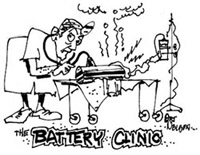One of the failure modes in Ni-Cd cells is shorting. While many things can contribute to shorting
one of the significant contributors is cadmium migration through the separator where it forms a conductive bridge, ultimately
shorting the cell
Cadmium migration is a function of the time the charge current is flowing through the battery and
less a function of the level of current. Therefore we have found that high pulses of charge current to maintain the charge
state are better than a steady low rate (trickle) current. This is very difficult to quantify as their are many other factors
contributing to the life equation but improvements in battery life of 10 to 20 percent by pulse charging vs trickle are not
unrealistic.
Therefore we have found the sustaining a pack at the fully charged state by way of pulsing the charge
is better than an continuous trickle charge.
Some charges employ this technique. You can do the essentially the same
thing rather simply and at a very low cost.
Simply connect your regular wall module charger that came with your system
to an appliance timer. Intermatic makes a good unit for around $5.00. Set the trigger pins on the timer so that it is on for
1 hour a day. When you return from a flying session turn the timer wheel so that the on off triggers come up in 14 to 16 hours.
Then turn the timer knob to on. This will give your pack a full charge and then a sustaining charge for 1 hour a day. The
battery can be left in this manner for a long time between flights and still be maintained at a fully charged state with minimal
overcharge.
If you only fly a couple of flights, you can just set the timer so that you get 6 or 8 hrs before you go
into the 1 hr.day mode. If we assume a normal 2 hr flight time for a system and you only fly 20 minutes. Then the charge you
need to return is 20/120 times 16 hours, or about 3 hours.
Know what your system consumes in the way of energy per
minute of flight. This can be determined by first charging a pack and then discharging it on a cycler to determine how much
capacity it has - fully charged. Then recharge and go fly. Record your system on time and immediately discharge the pack when
you return home. This will tell you how much capacity you have left. Lets say you fly for 40 minutes and when you discharge
the pack you get 390 mAh. From your initial discharge from a fully charge pack you got 585 mAh. This would mean that you discharged
195 mAh in the 40 minutes you flew or about 5 mAh/min. From this you would know that your pack is good for 116 minutes
of flight time under the actual flight loads. Now we don't want to take it this close so give yourself (and your
plane) some margin of safety -25%. So this would set your SAFE flight time to 75% of 116minutes or 1 hour 27 minutes. This
should be done for each plane. Also it should be done for your transmitter at least once just to accurately characterize
its "flight time". The system usage will vary, depending on your flying style, size of the plane and number of servos
used.
cls 5/22/97
Rev 2/24/04

